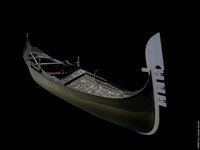Die Brosche ist kronenförmig mit Similisteinen (Strass) montiert. Unten sind drei Wachsperlen angehängt. Auf der Rückseite befindet sich eine Verschlussnadel aus Metall.
Strass- oder Similisteine werden seit dem 18. Jh. verwendet, um Diamanten zu imitieren. Der elsässische Juwelier Georg Friedrich Strass widmete sich in seinem Pariser Betrieb der Herstellung von Diamantimitationen, hatte großen Erfolg und durfte sich ab 1734 Juwelier des Königs nennen.
Die Brosche wurde von der Fa. Glaser in Neugablonz hergestellt. In Neugablonz siedelten sich nach dem 2. Weltkrieg verschiedene Schmuckhersteller an, um die Tradition des Gablonzer Schmucks weiterzuführen. Auch Jablonec nad Nisou in Tschechien (ehemals Gablonz) ist bis heute ein Zentrum der Glasherstellung und des Modeschmucks.
en

